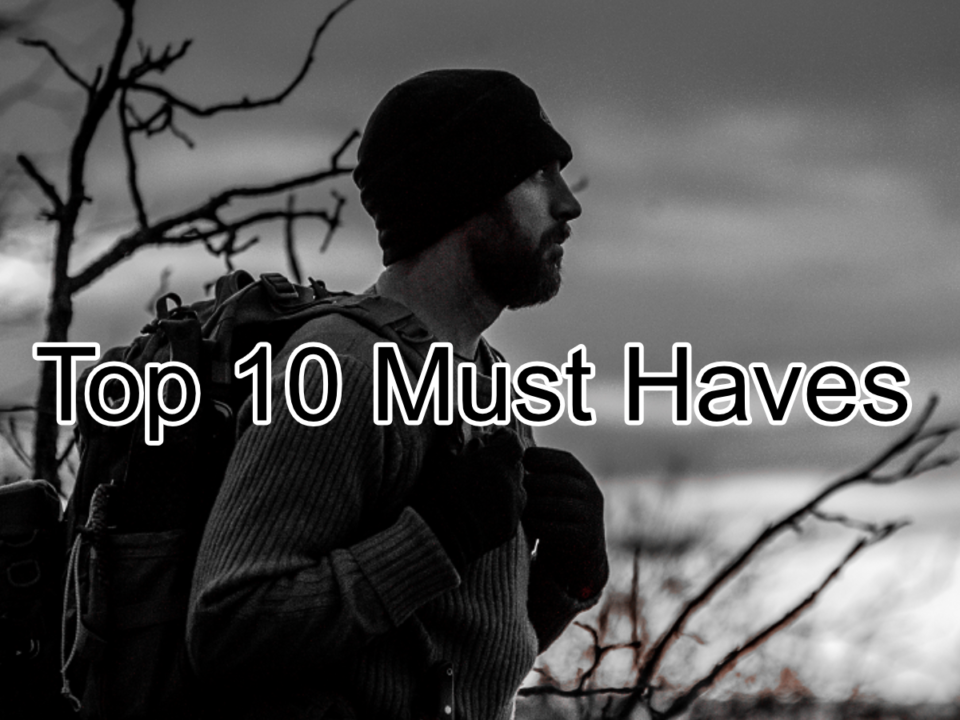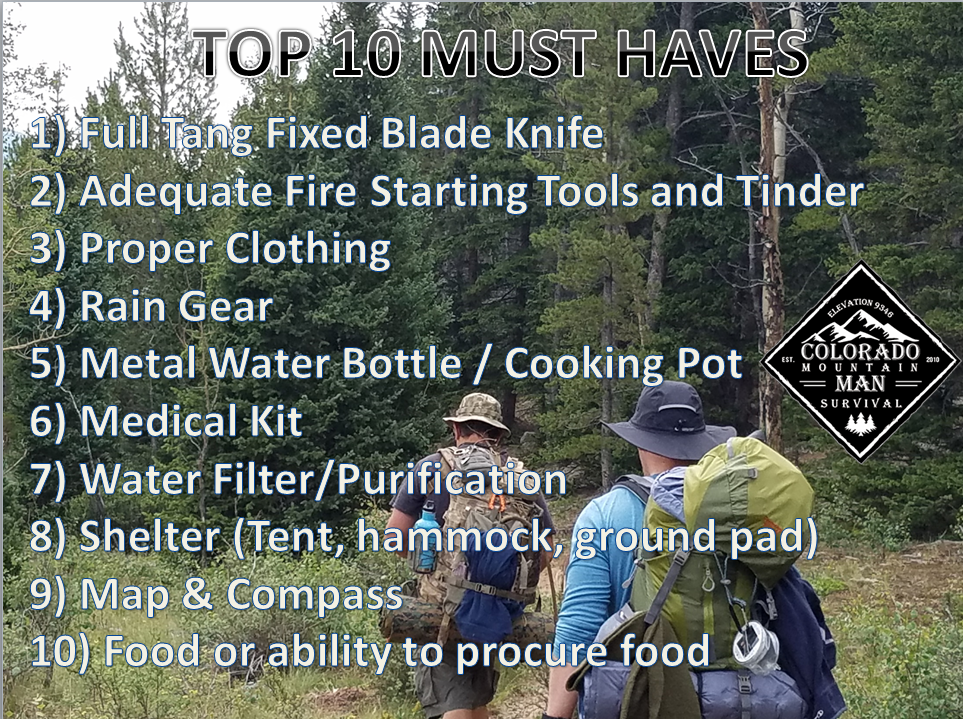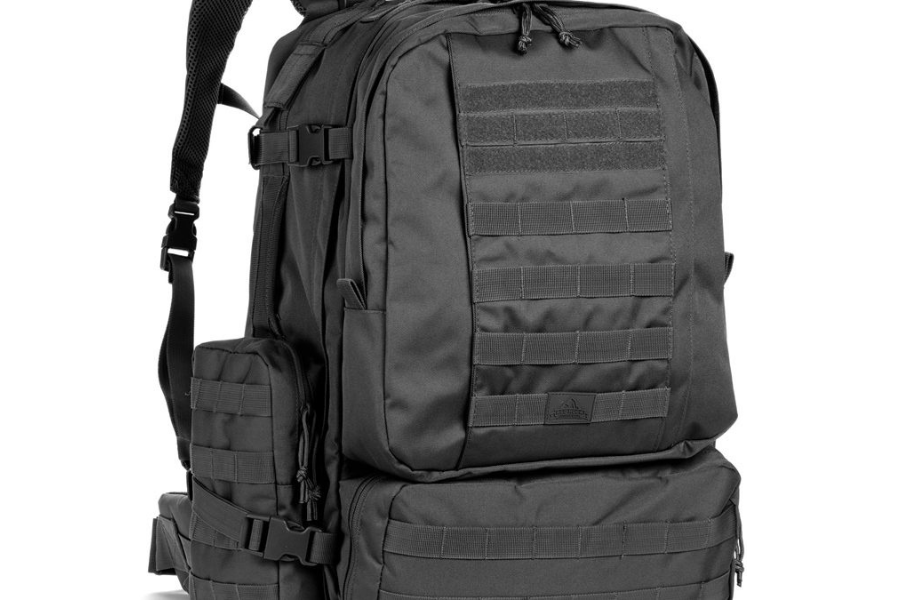Cart

Top 10 Must-Haves
Humans are no longer naturally equipped to thrive in the wilderness unaided. Our greatest survival asset is our brain, which has allowed us to innovate, creating tools and harnessing fire to overcome the challenges of nature.

Essentials for Survival: A Guide to Backcountry Preparedness
Our ancestors, masters of resourcefulness, relied on primitive tools to thrive in challenging environments. Over generations, we’ve refined these tools, but modern life has distanced many of us from the knowledge of how to create them. When venturing into the backcountry, it’s important to bridge this gap by bringing the right gear with you..
Survival situations can arise unexpectedly, and having the right tools can be the difference between a manageable experience and a dangerous ordeal. Below, we elaborate on 10 must-have items that will significantly improve your odds of staying safe and comfortable in the wilderness.
1. Full Tang Fixed Blade Knife
A dependable knife is the cornerstone of survival. A full tang fixed blade is durable, reliable, and versatile, ideal for cutting, carving, chopping, and even self-defense.
- Why Full Tang? The blade and handle are a single piece of metal, making it stronger than folding knives or partial tang designs.
- Uses: Building shelter, making tools, processing firewood, preparing food, and even first-aid applications.
When choosing a knife, look for one with a sturdy sheath and a comfortable grip to ensure safe and effective use.
2. Adequate Fire Starting Tools and Tinder
Fire is life in the wilderness. It provides warmth, cooks food, purifies water, and keeps predators at bay.
- Primary Tools: Bring multiple fire-starting methods, such as waterproof matches, a ferrocerium rod, and a Bic lighter.
- Tinder: Include materials like cotton balls coated in petroleum jelly, char cloth, or commercially made fire starters.
Practice using these tools before heading out to ensure you’re prepared to build a fire in various conditions, including wet or windy environments.
3. Proper Clothing
Dressing appropriately for the weather is vital for regulating your body temperature and preventing hypothermia or heat exhaustion.
- Layering: Wear moisture-wicking base layers, insulating mid-layers (like fleece, wool or down), and a protective outer layer to shield against wind and rain.
- Materials: Avoid cotton, which retains moisture and can lead to heat loss. Opt for wool or synthetic fabrics instead.
Always check the forecast and pack clothing that can adapt to changing conditions.
4. Rain Gear
Sudden rainstorms are common in the backcountry, and getting wet can quickly lead to hypothermia, even in mild temperatures.
Wet is cold! Cold is dead!
- Essentials: A waterproof jacket and pants are non-negotiable.
Pro Tip: Ponchos can double as emergency shelters or ground covers.
Choose lightweight and packable rain gear to ensure you’re protected without adding bulk to your pack.
5. Metal Water Bottle / Cooking Pot
Water is essential for survival, and a metal water bottle or pot serves multiple purposes.
- Why Metal? Unlike plastic, metal can withstand heat, allowing you to boil water directly in it for purification.
- Multi-use: A metal container can also be used for cooking or melting snow in cold environments or as a hot water bottle to warm your core body temperature.
Bring a container with a wide mouth for easier filling and cleaning.
6. Medical Kit
Accidents can happen, even to the most experienced adventurers. A well-stocked medical kit is critical for treating injuries and preventing infections.
- What to Include: Bandages, antiseptic wipes, tweezers, gauze, adhesive tape, blister care, and any personal medications.
- Advanced Additions: An advanced medical kit goes beyond basics, equipping you to handle severe injuries like heavy bleeding, fractures, burns, or wound care in remote settings. Items such as tourniquets, splints, hemostatic gauze, wound closure strips, and CPR masks are critical additions, but proper training, like a Wilderness First Responder course, is just as important to use these tools effectively.
Regularly check your kit to replace expired items and ensure it’s ready to go when you are.
7. Water Filter/Purification
While water sources may seem pristine, they can harbor bacteria, viruses, and parasites.
- Options: Use filters, purifiers, or chemical treatments like iodine or chlorine dioxide tablets.
- Backup: Boiling water is the most reliable method of purification if your primary tools fail.
Always have multiple ways to purify water, as hydration is critical for survival.
8. Shelter (Tent, Hammock, Ground Pad)
Protection from the elements is necessary for staying warm, dry, and safe.
- Options: Lightweight tents, hammocks with rain tarps, or even bivvy sacks.
- Ground Insulation: A sleeping pad prevents heat loss to the ground and adds comfort for restful sleep.
Choose a shelter system appropriate for the season and terrain you’ll encounter.
9. Map & Compass
Navigation tools are indispensable, even in the age of GPS.
- Why Traditional Tools? GPS devices can fail due to dead batteries, poor signal, or technical issues. A map and compass are reliable backups.
- Learn the Skills: Take a navigation course to build confidence in using these tools effectively.
Always carry a topographic map of the area and a compass, and keep them accessible in your pack.
10. Food or Ability to Procure Food
While you can survive weeks without food, having access to calories keeps your energy and morale high.
- Packable Options: High-calorie snacks, energy bars, or dehydrated meals.
- Procurement: Learn basic skills like fishing, trapping, or foraging to supplement your supplies.
Include lightweight cooking gear and utensils to prepare meals efficiently.
Be Prepared, Not Overloaded
Packing for survival is about balance. While it’s important to have the tools listed above, it’s equally critical to ensure your pack isn’t so heavy that it hinders your mobility.
Practice using your gear before heading out, and keep refining your setup to suit your specific needs and environment. By bringing these essentials, you’re not only prepared for the unexpected but also empowered to handle challenges with confidence and skill.
Stay safe, stay prepared, and embrace the adventure!
Leave a Comment
Top 10 Must-Haves
Discover the top 10 must-have items for wilderness survival in this blog post. Ensure you're prepared for any outdoor adventure.
WHAT TO PUT IN YOUR BUG OUT BAG
We have the most in-depth bug out bag list to help you know exactly what essentials to put in your bug out bag for your...

